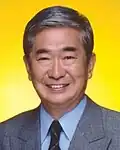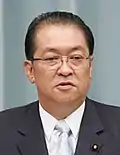| ||||||||||||||||
| Turnout | 57.87% | |||||||||||||||
|---|---|---|---|---|---|---|---|---|---|---|---|---|---|---|---|---|
| ||||||||||||||||
| ||||||||||||||||
The 1999 Tokyo gubernatorial election were held on April 11, 1999 as part of the 14th unified local elections. Incumbent Yukio Aoshima announced that he would not seek re-election. All major candidates ran as independents but several were supported by major parties. The Liberal Democratic Party, led by Secretary General Yoshiro Mori, supported Yasushi Akashi as a compromise with coalition partner New Komeito, but local LDP legislators divided their support between candidates Ishihara, Masuzoe and Kakizawa.
Author and former Diet member Shintaro Ishihara, who had previously come in second in the 1975 gubernatorial election against incumbent governor Ryokichi Minobe,[1] won the election on a nationalist platform, saying that he would have the United States return Yokota Air Base to Japan and clarify its position on Japan's ownership of the Senkaku Islands. Akashi came in fourth, the poorest showing by an LDP-supported candidate in Tokyo history.[2]
Results
| Party | Candidate | Votes | % | ±% | |
|---|---|---|---|---|---|
| Independent | Shintarō Ishihara | 1,664,558 | 30.47% | ||
| DPJ, TSN, Kaikaku Club | Kunio Hatoyama | 851,130 | 15.58% | ||
| Independent | Yōichi Masuzoe | 836,104 | 15.30% | ||
| LDP, NK | Yasushi Akashi | 690,308 | 12.63% | ||
| JCP | Mitsuru Mikami | 661,881 | 12.11% | ||
| Independent | Kōji Kakizawa | 632,054 | 11.57% | ||
| Independent | Yoshirō Nakamatsu | 100,123 | 1.83% | ||
| Turnout | 5,510,042 | 57.87% | +7.2% | ||
- Note: Excludes twelve other candidates, none of whom received more than 0.3% of total votes.
References
- ↑ Allinson, Gary D. (1979). Suburban Tokyo: A Comparative Study in Politics and Social Change. University of California Press. p. 185. ISBN 9780520028425.
- ↑ Kristof, Nicholas (12 April 1999). "Nationalist Critical of U.S. Air Base Is Elected Governor of Tokyo". The New York Times. Retrieved 8 January 2014.

